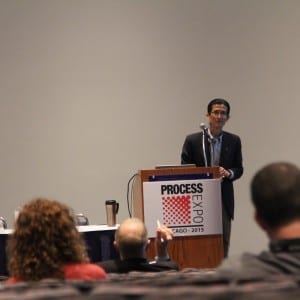
There’s much more to food packaging that just protecting eats for the consumer or making a product look more appealing. By engineering innovative polymers and addressing critical issues such as shelf life, packaging can help tackle global issues such as hunger, waste and the environment. Recently at PROCESS Expo in Chicago, I had the chance to sit down with Dr. Loong-Tak Lim , an associate professor of food science with the University of Guelph to find out what’s trending in food packaging. Here’s what he identified as some of the biggest ideas shaping the future of how we wrap, shop for and make food. Biodegradable Isn’t Always Best: For environmentally conscious consumers, the words “biodegradable” and the snazzy green-arrow triangle make for feel-good packaging. But Lim says consumers often don’t realize it isn’t always the greenest choice. While biodegradable packaging materials can be broken down in the compost, they will sit in landfills for a long time due to the lack of proper microorganisms and conditions, Lim says plastics companies may make a better choice for the environment by using polymers that are recyclable and made from renewable sources like sugar or other by-products. “You have to do a life-cycle analysis,” Lim explains. Coca Cola, for example, recently unveiled a plastic bottle made in partnership with Virent that uses plant-based PET instead of petroleum – which is overall a better deal for the environment. Lim says this choice is also often better for manufacturers because instead of needing to change equipment to make biodegradable plastics, renewable polymers drop into the same machines to produce the same product. Packages That Communicate: Imagine walking into a store, seeing food packaging with limited information – like actual product freshness and expiration date – and being able to scan it with your phone […]


